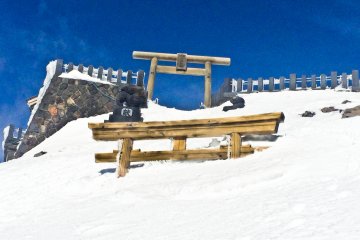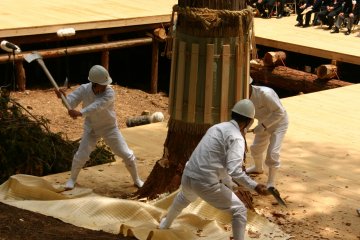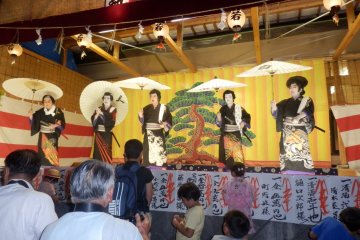The little town of Agematsu rests in the Japanese Alps alongside a rugged mountain stream and surrounded by the Akasawa National Forest, home of Kiso cypresses over 300 years old. These grand trees have survived to today because of the strictest of environmental protections, an anti-logging policy of “One tree, one head” that dated back to the time of Shakespeare. On a lighter note, this is also the home of “forest bathing,” a practice that has called scientific attention to the health benefits of being in nature.

The forest has thus been nurtured by humans for centuries and thrived with the support of the local community. David George Haskell, in The Songs of Trees, suggests that attempts to preserve forests in their “natural” and “primeval” condition have the consequence of excluding humans from the “natural” community of life. Here, humans live with the forest, appreciating its benefits and sustaining the ecosystem.
The cold of this region causes slower growth of the cypress trees, locally known as hinoki, resulting in denser lumber of superior quality. Ironically, when the Ise Grand Shine was being rebuilt and needed new timber, a ceremony was held to harvest the trees here, generating attention resulting in renewed interest in the forest and its preservation.

The old narrow-gauge Forest Railway has been revived for recreational use and makes for a special way to experience this place. An industry in products made from the trees has also grown, with woodworks and cypress essential oil becoming leading souvenirs here. Furthermore, extensive hiking trails through the forest and past dramatic waterfalls as well as the fantastic blocky boulder formations of Nezame no Toko along the river, all under a sky full of stars at night, have created a superb environment for all walks of life to enjoy the forest.
Highlights of Agematsu
Surrounded by the national forest to the west and the Central Alps to the east, sightseeing attractions and highlights in the area are predominantly natural. Mt. Kiso-Koma (Kiso-Koma-ga-take) is the highest of these and provides some of the best views in the area with its famous craggy summit reaching nearly 3000 meters. There are multiple-day hiking routes here worthy of experienced mountaineers.
To get deep into the woods and experience forest bathing, head for the national forest, also known as Akasawa Natural Recreational Forest. Shinrin-yoku has its origins in the 1980s and is actually a recognized form of preventive health care and healing that reduces stress, heightens the ability to focus, and increases energy when one absorbs the forest atmosphere. Research has even noted reduced blood pressure and heightened immune system responses in participants. For some, though, it has always been intuitive: just go for a leisurely walk and immerse yourself in a beautiful forest—taking it in perceptively with your senses and connecting to it—you’ll feel good! Now, the science is helping is learn why and how.

Taking the Forest Railway is the ideal means to chug straight through the forest and the abundance of natural scenery. The station area has parking and museums, and several of the walking paths start from here. The train was key to the local economy and forest industry in years past and, after a period of being out of service, has been remarkably restored. The railroad is open from late April to early November and closes during the winter due to snow. The tracks follow the Kiso River, and one of the major highlights is Nezame no Toko. This gorge gives a memorable impression with its distinct rock formations that contrast white granite boulders against the emerald green waters.
Festivals, food and local crafts in Agematsu
Events in the area are numerous and act to connect the inhabitants to the nature around them in a variety of ways. Forest bathing days are held twice a year for visitors with reservations. There's a winter lantern festival in mid-February with warm food and snow statues. And lion dances and kabuki performances can be seen at local shrines. Summer has log-pulling competitions, fireworks and more. For more information, refer to the official event calendar.

Famous local dishes include soba noodles, pickles, and gohei-mochi (skewered rice cakes). Many establishments also take advantage of ingredients from the surrounding fields and mountains—particularly vegetables. The town has numerous restaurants to satisfy all tastes including curry, barbecue, sushi and more.
Crafts in Agematsu center around the traditional woodworking industry. From frames to flooring all of the basics are covered. For travelers, selections such as utensils, cups, and even traditional toys can make a fine souvenir with the smooth touch and characteristic woody fragrance of Kiso cypress tree products.
Staying in Agematsu
Agematsu represents the picture-perfect rural escape for those looking for a forest-mountain getaway. The railway provides a quick introduction to the region along its 2.2 km roundtrip, but the full Agematsu experience includes guided walks, hiking and foresting bathing—even full-on therapy sessions.
For those keen on multiple-day stays here, options exist along National Route 19 (Kakehashi Onsen Ryokan, Tamasa Ryokan, and Sakaiju Ryokan), in the Akasawa National Forest area (family-run lodges, including Nishiogawa, Sawaguchi and Kyoraiso), and even while hiking up to Mt. Kiso-Koma (mountain huts Kiso, Tamanokubo and Kisotono).
You just might find some happiness under the trees in Agematsu.
















